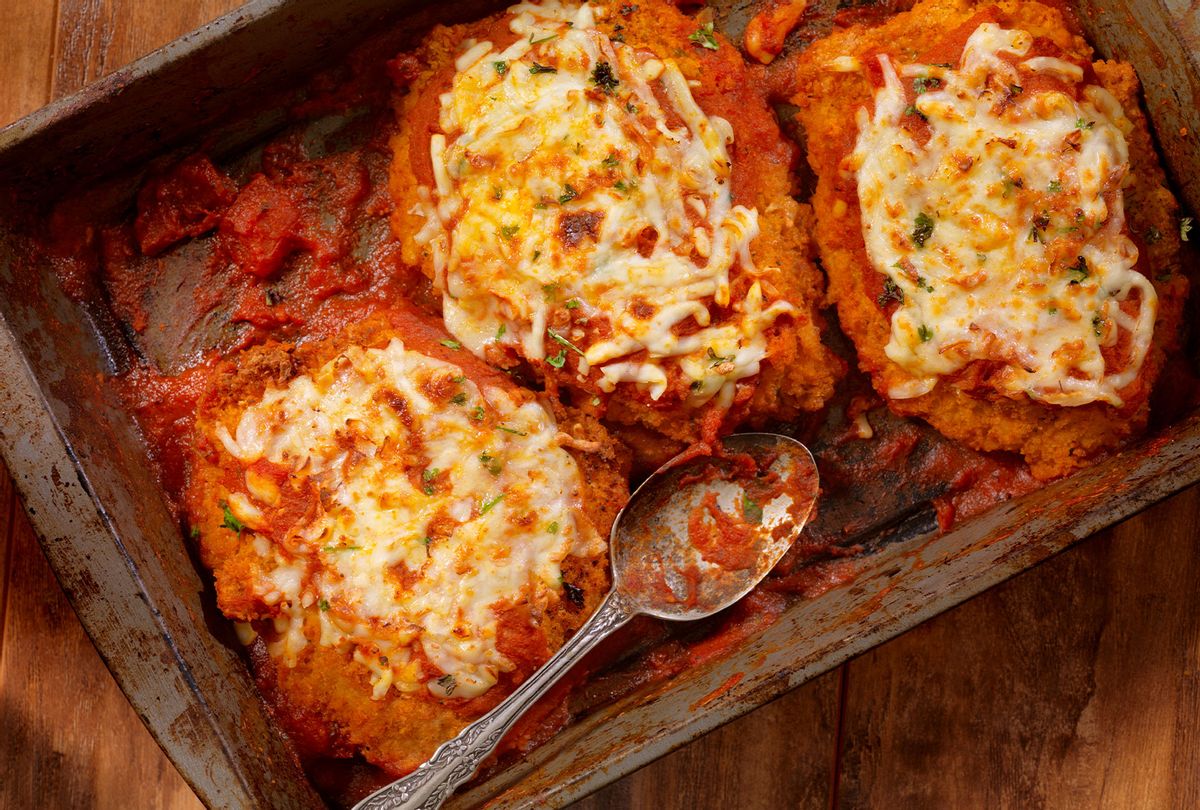
In the fourth episode of "Hacks," one of my favorite shows of the year, the final moments center on an exchange between Jean Smart's Deborah Vance and her assistant Ava (Hannah Einbender) about a room service order.
"I think they may be overcharging you for room service," Deborah says. "They have you ordering 3 chicken parms in one night? I think they made a mistake — I don't like being overcharged"
"Three chicken parms? In one night?" Ava responds. "That's crazy … but I did order them"
"What, were you entertaining?" Deborah exclaims incredulously.
"No, it was just me," Ava said. "But they're medium-size, though, and I eat the leftovers for breakfast, so you're actually saving money"
This exchange truly encapsulates my ethos and adoration for chicken parmigiana. Chicken parm is my ultimate comfort food. No frilly intros here — that's it. I find "comfort food" to be a silly concept because it varies so much and is so dependent on so much: culture, childhood nostalgia, location, food sensitivities and allergies, sociopolitical and economic status, ethics. But, speaking for me and me alone, chicken parmigiana epitomizes the entire notion.
The Italian-American "red sauce joint" has many a chicken dish in their oeuvre, but chicken parm is clearly the apex and confluence of weeknight meal, red sauce joint staple and comfort food. In the seventeen or so years that I've been cooking, I don't think there is a single dish I've made as often as chicken parm.
The renditions I made as a 16-year-old took me half the day and were a true exertion of energy, but fast forward a little over a decade and I'm now whipping up the dish in under an hour without breaking a sweat. Pardon the cliche, but I could truly cook chicken parm with a blindfold on at this point. The aroma, the taste, the muscle memory — it's all coalesced into something that is a deeply satisfying food experience, from the start of cooking to the last bite of chicken.
Historically, the tale goes as such: a slightly lighter version of chicken parm originated with melanzane alla parmigiana — otherwise known as eggplant parm — in southern Italy. After many Italians immigrated to the US, protein was more abundant, and the ingredient of choice switched from eggplant to chicken. By the mid-1950s, the Italian-American restaurant had begun to proliferate the East Coast, and with it, the chicken parm began to spread in ubiquity.
In 1962, the New York Times shared a chicken parm recipe and the rest is history.
My chicken parm is reliable, dependant and a constant. I know that I can bread chicken, I know that I can make sauce, I know that I can top chicken and sauce with copious heaps of cheese with reckless abandon. And I know that it'll taste delicious.
Making chicken parm is also inherently tangible — the entire breading process, the frying, dousing in cheese. The contrasts of texture is what always gets me: moist chicken, thinly sliced or pounded, shatteringly crisp, pan-fried or deep-fried coating, piquant marinara, and heaps and heaps of cheese. There is no equal.
There is, of course, something inherently contradictory within chicken parm — why take the time to render a perfectly crispy piece of pan-fried or deep-fried chicken, just to then slather it with an explicit amount of sauce and cheese, rendering it soggy and devaluing all of the work you put in to ensure its crispness?
In order to counteract this, you just need to change up your typical technique a little bit. Instead of topping the crispy cutlets with sauce and cheese before going into the oven, instead layer the sheet tray with sauce and cheese and place the chicken atop it. This ensures the chicken stays crisp while you still get a bite of cheesy-saucy goodness.
I take my chicken parm. to the edge of glory (a.k.a burning). I like the cheese to get as bubbly and crisped and browned as possible, crisping the contents of the sheet tray in both the oven and broiler until the dish is perfectly bronzed. Frankly, it's not the most balanced dish. The only acidic component is the tomato — everything else is pretty laden — but no one is indulging in chicken parm for its nutritional benefits, right?
My ultimate chicken parm. dinner is always rounded out by a glass of ice cold Mountain Dew (I'm sorry) and a side of either penne, rigatoni or spaghetti. My favorite part of chicken parm, frankly, is not the chicken at all — I heap so much cheese on my cutlets when making chicken parm that the cheese essentially melts across the entire surface of the sheet tray, bubbling and crisping in the heat until the entire tray is "parmed."
As it cools, I love to eat the shards of melted cheese. Chef's treat!
***
Recipe: Simple Marinara
Serves 4 to 6
Ingredients
- Extra virgin olive oil
- ½ large onion or 1 small onion, finely chopped
- 3 to 4 garlic cloves, minced
- 2 tablespoons tomato paste
- 2 (28-ounce) boxes crushed tomatoes, ideally San Marzano
- ¼ cup water, wine, or stock (aim for unsalted)
- Rind of Parmigiano-Reggiano
- Kosher salt
- Freshly ground black pepper, optional
- Herbs of choice (I generally go herb-less, but some are adamant about a basil or parsley inclusion)
- Kosher salt
1. Heat olive oil in a medium-sized pot over medium heat.
2. Add onion and cook for 5 to 7 minutes, until translucent.
3. Add garlic cloves, toast for 30 seconds, and then add tomato paste.
4. Stir and cook until mixture becomes brick-like in color and the tomato paste begin to caramelize.
5. Add crushed tomatoes, water, wine, or stock, and rind. Salt generously, add pepper if using, and be sure to taste it. It is so important to taste red sauce for seasoning.
6. If using herbs, add just before serving. Stir well.
[Author's note: I'm vehemently anti-adding sugar to tomato-based sauces, but I will note that I typically use boxed, crushed tomatoes — I try to steer clear of cans — so if you're using legitimate off-the-vine tomatoes, the acidity can certainly vary. I find sweet tomato sauces to be the culinary equivalent of stepping in a puddle with socks on, but if you're really into sweet sauces, go wild.]
***
Recipe: Chicken Parmigiano
Serves 4 to 6
Ingredients
- 1 pound boneless, skinless chicken breasts (either sliced in half or purchased 'thinly sliced')
- 1 cup of Simple Marinara
- Kosher salt
- Freshly ground black pepper
- ½ cup Panko
- ½ cup regular bread crumbs
- 8-ounce block Parmigiano-Reggiano, grated on microplane, divided; plus more to taste
- 1 ½ teaspoons onion powder
- 1 ½ teaspoons garlic powder
- 3 eggs, whisked with 1 ½ tablespoons milk, half-and-half, or water
- ½ cup AP flour
- ¾ cup neutral oil (canola, vegetable, grapeseed, etc.)
- Fresh mozzarella
- 1 package shredded mozzarella
- Additional cheeses, if using (fontina, asiago, "Italian blend," etc.)
- Handful of chopped parsley
- 3 to 4 pats of unsalted butter
1. If you've purchased thinly sliced chicken, ignore this step. If you haven't, carefully slice chicken in half horizontally. Season both sides generously with salt and pepper.
2. Set up your SBP (standard breading procedure). In a shallow bowl, mix flour with salt, pepper, onion powder, garlic powder, and some grated Parm. In another shallow bowl, place egg mixture. In a third bowl, toss both breadcrumbs, Parmigiano, onion and garlic powder, salt, and pepper.
3. Heat oil in a large, heavy-bottomed saucepan or saucepan over medium heat.
4. Dredge chicken cutlet in flour, turning to coat, then move to egg mixture, turn to coat and let excess drip off back into bowl, and then transfer to breadcrumb mixture. Turn to coat and use fork, tongs or hands to slightly "pack" breading onto chicken. Repeat with the rest of the chicken.
5. Add chicken to pan, only a few pieces at a time so as to not overcrowd, and cook, turning as few times as possible, until deeply, deeply browned and crisp. Transfer to a wire-rimmed rack or paper towel-covered plate and sprinkle with flaky salt. Repeat with remaining chicken cutlets.
6. On a large sheet tray, spread tomato sauce "wall-to-wall." Top with cheeses (both mozzarellas and Parm), spreading out into one "layer." Top with crispy chicken and — if you'd like — more cheese.
7. Sprinkle parsley over top and dot cutlets with small pats of butter to ensure thorough, deep browning. Place in the oven, cook until cheese has melted and then transfer to broiler until tops of chicken are crisped and bronzed.
[Author's note: swapping out marinara for vodka or butter chicken sauce is *chef's kiss*]
Salon Food writes about stuff we think you'll like. Salon has affiliate partnerships, so we may get a share of the revenue from your purchase.
Article From & Read More ( Want impossibly crisp chicken parmesan? Try this simple sheet pan layering trick - Salon )
https://ift.tt/3dxuyFT











